CEO Dare to Cure: Dominique Epthorp talks about son Ashton’s cancer journey
A routine trip to the doctor to see about six-year-old Ashton Epthorp’s cough turned into a two-year crusade against cancer, including a nine-month hospital stay, for the Epthorp family.
Sydney Weekend
Don't miss out on the headlines from Sydney Weekend. Followed categories will be added to My News.
Digger-obsessed Ashton Epthorp was six years old, learning to ride a bike and running around with his younger sister when he was diagnosed with cancer.
The St Albans youngster was in Year 1 in 2022 when he came down with what mum Dominique thought was the flu — she took him to the doctor, who sent him for a chest X-ray. The X-ray showed that the whole of Ashton’s left side of his chest was whited out, presumably due to a build-up of fluid.
Just after midnight, a doctor woke Dominique — a 35-year-old schoolteacher who was pregnant with her third child at the time — to tell her that what had appeared to be fluid on the X-ray was actually a giant mass threatening to cut off Ashton’s airway. Testing confirmed the diagnosis as T-cell acute lymphoblastic leukaemia (T-ALL).
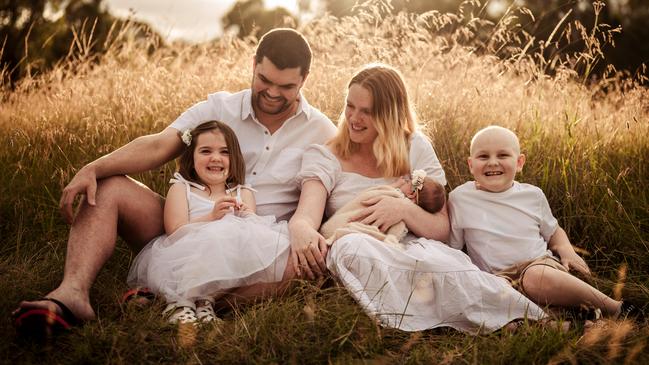
Over the next year and a half, Ashton underwent 21 debilitating procedures. He also got severe toxicity from one of the chemotherapy drugs, causing his kidneys to stop working and his blood pressure to skyrocket.
Thankfully, in January last year, Ashton was declared in remission. Earlier this month he finished treatment for the last time.
The eight year old continues to have ups and downs, but is happy to be at home with dad Justin and loving sisters Savannah, six, and Hayley, almost two.
He’s back at school and thriving.
IN HIS MUM’S WORDS
“For Ashton, it all started with a cough that wouldn’t go away.
Being winter, we assumed he had picked up a cold and he would recover quickly, but sadly that wasn’t the case.
He became clingier and more emotional than usual — which we attributed to being run down. He had bruises on his legs — we thought these were from learning to ride his bike without training wheels. At times he looked pale and had some shortness of breath which was concerning.

The GP listened to his lungs, ordered a chest X-ray and prescribed a course of antibiotics. As soon as the chest X-ray came back abnormal with the entire left side of his lung whited out, the doctors assumed this was due to fluid and diagnosed Ash with atypical pneumonia.
After he had completed his week-long course of antibiotics we returned for a follow-up appointment. I remember thinking he seemed better and should be OK to return to school soon. He was eating well and still running around and playing with his sister at home.
The GP listened to his lungs again at the follow-up appointment and she called in a second doctor to come and take a listen to his lungs. I noticed as Ash took off his shirt for the examination that the left side of his chest was actually protruding in an abnormal way.
Both doctors thought they heard crackling on his lungs and his blood oxygen levels were not good so the decision was made by the GP that Ashton needed to be seen in emergency.
I remember being so shocked that they were sending him to emergency – I truly thought he may have just needed another course of antibiotics.
I called my husband to meet us with our daughter, and together we made the two-hour drive to the nearest children’s hospital.
I waited alone with Ashton in emergency for hours to be seen.
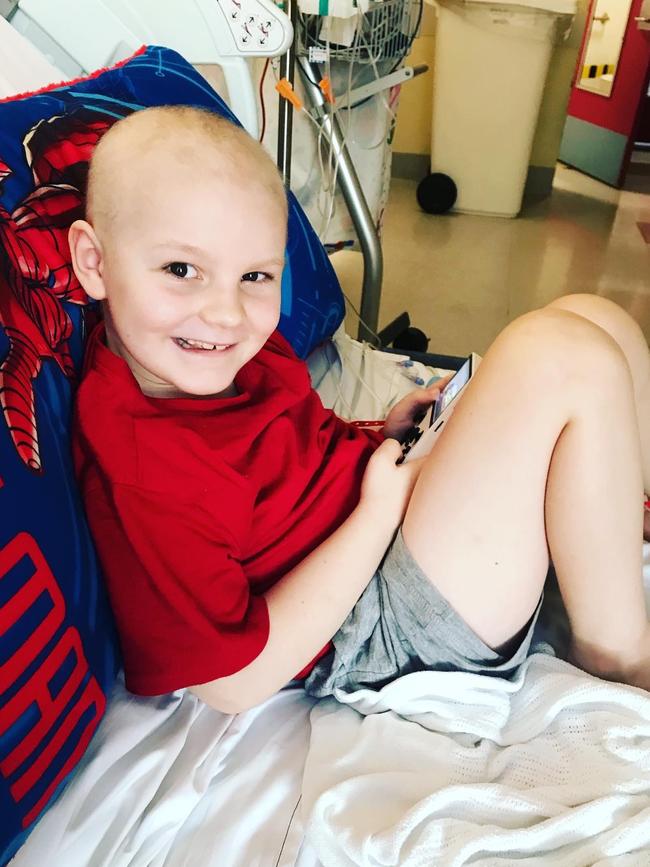
Finally at 10pm he was seen by a doctor who ordered additional chest X-rays and the blood test that I credit with saving Ashton’s life.
He was admitted to the hospital that night. I was woken by a doctor just after midnight to say that his blood results had come back abnormal and they were running more tests.
I wouldn’t find out any more information until the next morning – which was the day our world changed forever.
We came to the hospital expecting to be sent home with stronger antibiotics and unfortunately we were not able to return home for the next 9½ months.
To find out he was critically unwell and hearing a doctor say “your son has blood cancer” was an unbelievable shock.
We couldn’t understand how we had missed all the signs and symptoms. It was hard to reconcile that he didn’t have pneumonia – all of his symptoms were caused by cancer.
Those first two weeks in hospital were so terrifying and overwhelming. Nothing can prepare you for a childhood cancer diagnosis and it felt like our whole world stopped the day Ashton was diagnosed.
Our sole focus became getting him through his treatments over the next two years. It was a fight and we were on a steep medical learning curve to educate ourselves on everything we could about our son’s diagnosis and treatments.
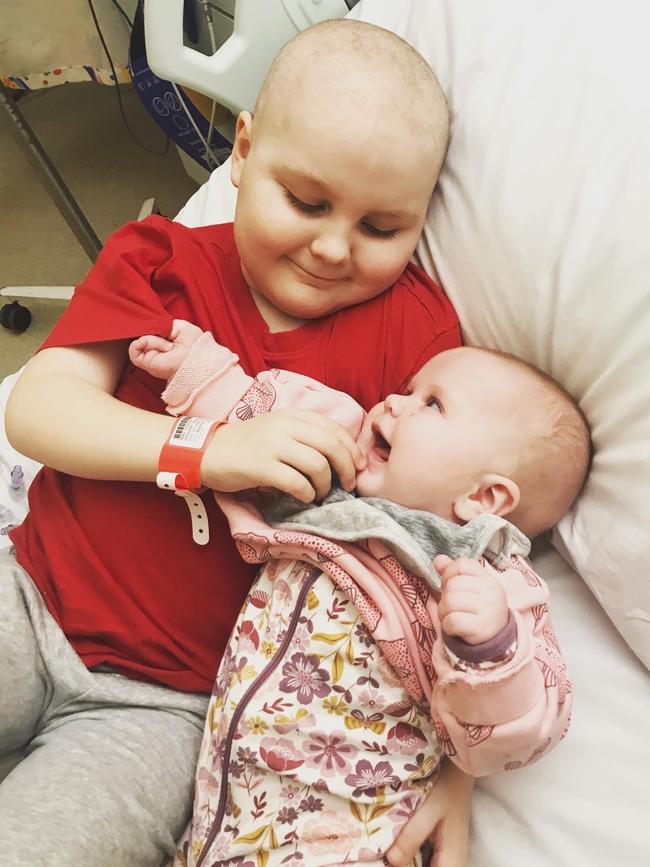
It was devastating to learn that toxic, outdated chemotherapy was the only treatment option available to cure him.
Treatment was incredibly tough, physically and emotionally, on Ash and our family.
We were extremely thankful to have family support – not just emotionally but also logistically as our middle child was not allowed in the hospital for the majority of Ashton’s hospital stays due to visitor restrictions.
The separation and isolation caused by treatment was one of the hardest parts. We didn’t have a choice but to keep going and do the best we could to be there for our children.
Many teary video calls were had from his hospital bedside to keep in touch with my daughter, who was only four at the time.
We also added a beautiful baby girl to our family when Ashton was almost three months into his cancer treatments, and that added another element of difficulty to juggling all of the unplanned hospital admissions that came with Ashton’s high dose chemotherapy treatments.
However, she also brought a lot of hope and happiness to what was otherwise a dark and challenging time.
Some admissions, the only time Ash could muster a smile was when his newborn sister was able to come visit.

We leaned on our hospital social worker, who was an amazing support, and other cancer support charities. The other families we met at the children’s hospital were such a pivotal source of support and they helped us through the long and difficult admissions.
For our family, becoming involved with the Children’s Cancer Institute and being able to help advocate and fundraise for kinder treatments has been an incredibly positive and healing experience.
We know first-hand how hard the researchers there are working to find cures and develop kinder and more effective treatments. That alone gave me a lot of hope and comfort.
Ashton displayed amazing resolve through treatment, however there were some long and challenging admissions where the impacts of the toxic chemotherapy hit Ashton full force.
Being in isolation on the ward for weeks at a time takes a toll on mental health, not even being allowed to leave your hospital room and he had a few difficult admissions where he wouldn’t eat, stopped walking and had to slowly regain those skills to be able to be discharged from the hospital again.
Seeing your once-vibrant and energetic son go from being a picture of good health to needing a wheelchair to get around was heartbreaking.
Being away from home and not being able to attend school in person for over nine months was another heavy part of the journey.
Thankfully, the second phase of treatment allowed Ash to slowly regain his skills and finally return home and get back to school with his friends.
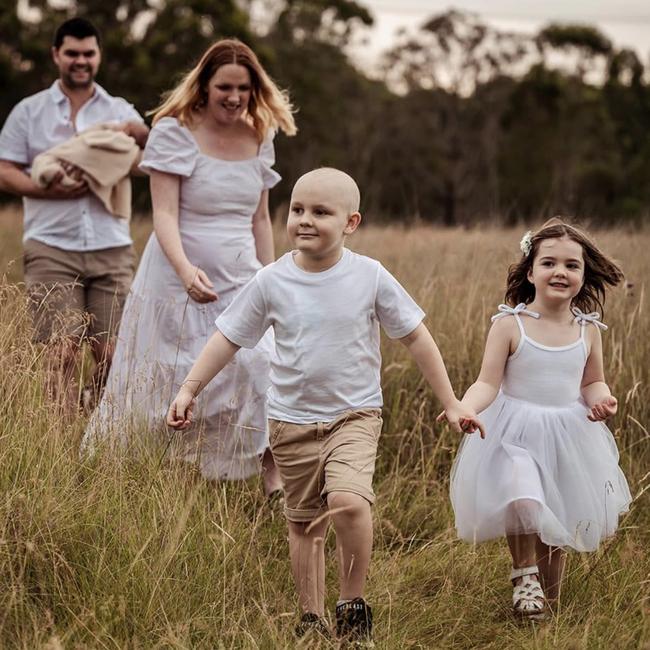
Throughout this entire journey Ashton has kept us positive by taking so much in his stride.
It has been heartbreaking to see how “normal” all the procedures, blood tests and hospital visits became to him. He is without a doubt my reason for everything I do.
I always tell him he is among the bravest of the brave and that I am forever proud of him. Ash, thankfully, is thriving now. He finished his two-year chemotherapy protocol on September 8 and he is so happy to be done with chemotherapy!
I look at him most days and marvel at how far he has come from his darkest days, when he couldn’t walk and the toxic effects of treatment had left him bedridden, unable to eat or drink.
Today he is back at school, catching up on the learning he missed while we were having to live away from home.
He is enjoying being back with his friends and I know he appreciates every small joy in life like being able to be home with his sisters, go to school again and getting back to being active and riding his bike.
He is my absolute hero and I am forever proud of him, not just for getting through all he did but for finding joy in life again.
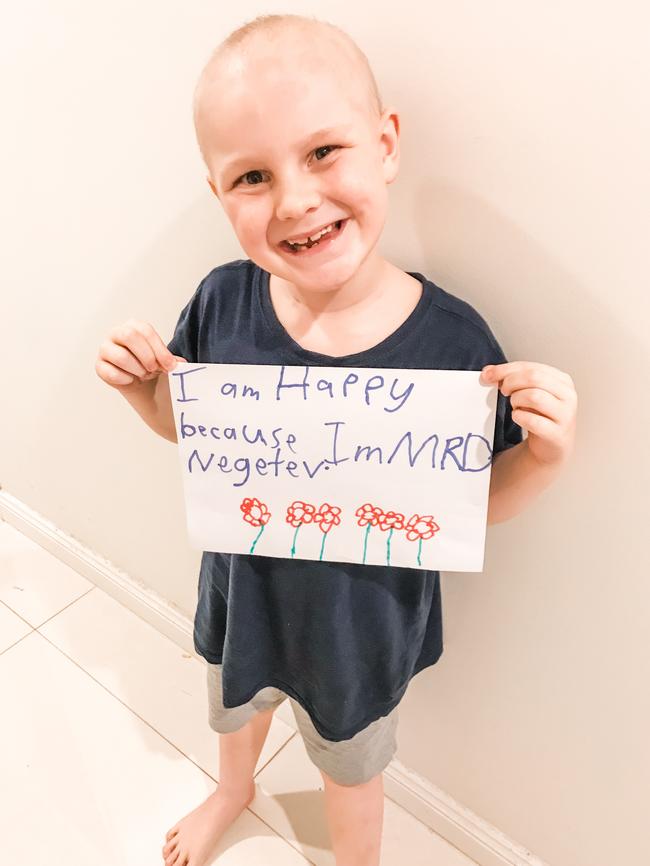
The end of treatment, while being a major reason to celebrate, also holds a lot of fear and uncertainty for us as parents.
I have to hope that all the treatments he has had to date will be enough to keep his cancer away for good. That he will continue to thrive and stay well off treatment.
Going through cancer and cancer treatment at just six years of age has definitely changed Ash. I think it forced him to grow up very quickly. He faces medical trauma from the vast amounts of medical procedures he has been through in the past two years and the treatments have also taken a physical toll on his energy levels and motor skills.
After a childhood cancer diagnosis, life will never fully return to what it was.
The past two years were spent living in survival mode with so much uncertainty about what each day would look like.
We have learned so much about childhood cancer by being thrown into this world and it completely changes your perspective knowing how much more needs to be done to save the lives of kids with cancer.
Now we appreciate all the little things so much more – like being able to be back home and seeing our kids get to attend school again. Just being able to be together as a family, under one roof, has been the most important thing.

To those facing a new childhood cancer diagnosis for your child, please give yourself so much grace in this time. You have a lot to process and a lot to learn and understand as all the medical information given to you in the beginning gets to be overwhelming.
It takes time to master all the medical terms and learn how best to advocate for your child. Also, there is a whole community of fellow oncology families ready to support you through whatever your family’s cancer journey holds.
Ashton is back at school, enjoying year 3 with his friends and he is enjoying being back to riding his bike and watching the NRL on TV.
He still has some medications to take each week as he is still considered immunocompromised. His body needs time to recover from years of chemotherapy. Any fever still earns him a hospital stay for at least 48 hours and IV antibiotics. He also has to have monthly blood tests and checks at the children’s hospital and will need ongoing monitoring for years to come. Late effects from chemotherapy are a very real probability and we don’t necessarily know the full impact his treatment has had on his body until symptoms show up.
While so many aspects of our life are back to how they were before cancer – life will never be as simple and carefree as it once was.
CEO Dare to Cure is an annual fundraising initiative from the Children’s Cancer Institute where brave CEOs and business leaders muster up the courage to face their biggest fears: from snakes, spiders, ice baths, shaving their head or even walking on broken glass, all in the name of fundraising for life saving childhood cancer research.
Our family is thankful to every single CEO taking on the challenge this year – it means the absolute world that you are willing to do hard things and fundraise so that children facing cancer can have a brighter future, targeted treatments and a long and healthy life.
To anyone thinking of taking on the challenge or considering supporting – please do it for the kids!
Children facing cancer have no choice but to display so much bravery on a daily basis – seeing others being brave, creating change and facing fears in their honour is the most inspiring thing!
I hope that anyone considering taking part or donating is inspired by their bravery.
The Children’s Cancer Institute was founded back in 1976 by two pioneering oncology parents who saw a need for research to improve the survival rates for children, like their own, who were diagnosed with cancer.
Their vision evolved into the only research institution in Australia solely dedicated to curing all forms of childhood cancer.
This year marks 40 years since their first laboratories opened and the researchers’ dedication to their mission to uncover cures for every child hasn’t changed in all that time. Donating directly to childhood cancer research through the Children’s Cancer Institute gives families like mine so much hope for the future.
It is if, not when, we find cures for childhood cancer and I hope it is something I get to witness in my lifetime.”





